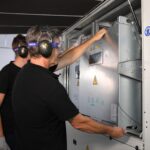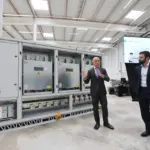The energy transition is a global process that involves the integration of renewable energy sources, energy storage technologies and smart grids. Professionals in the electricity sector are committed to this transition and are looking for increasingly efficient and integrated solutions to give a definitive boost to this transformation.
Energy generation and storage
The integration of energy storage systems into renewable generation systems and smart grids is one of the most interesting aspects of the current moment.
In the case of renewable generation systems, energy storage can mitigate the effects of solar and wind power intermittency and thus improve the stability and security of electricity supply.
Among the different energy storage systems, batteries are one of the most widely used technologies due to their flexibility and adaptability to different applications and environments.
Batteries work with DC and are a storage technology based on power electronics. However, they have a certain life cycle and deterioration due to their use, which is why the development of robust and efficient storage systems is one of the necessary conditions to get maximum productivity of the equipment and, consequently, also the profitability of the investment.
Energy storage systems based on lithium-ion batteries are currently one of the most widely used technologies in the electricity industry for storing renewable energy. This is because they have a higher energy density and require a lower investment. In addition, new battery storage technologies are being developed with significant improvements in storage capacity, lifetime, and safety. An article on this subject will be discussed later in this report.
In all cases, the improvement of battery technology is a constant in the energy industry, as improved battery capacity, durability and energy efficiency will enable the adoption of large-scale storage solutions and contribute to a higher penetration of renewable energies in the electricity grid.
As the sector’s specialist associations point out, we cannot manage an electricity system with 80 GW of renewable generation without seriously damaged the stability of the electricity grid and the guarantee and quality of supply. Hence the importance of also having storage in the energy transmission and distribution systems.
Electricity transmission, distribution and storage
Electricity storage also needs to be integrated into advanced electricity transmission and distribution systems, enabling more efficient management of the electricity grid.
In this respect, energy storage systems are used for:
- Improve the quality of electricity supply.
- Reducing energy losses in the grid
- To guarantee the stability of the grid.
Energy storage and smart grids
Storage technologies are combined with the development of smart grids, which enable more efficient and sustainable management of electricity.
Storage systems, together with technologies such as remote monitoring and control systems, demand management systems and renewable energy generation forecasting systems, enable smarter and more flexible management of the electricity grid, improving its energy efficiency and reducing its environmental impact.
In addition to electrical energy storage, the integration of grid charger-rectifiers into conventional electricity infrastructures enables a move towards smart and distributed electricity grids. These devices make it possible to charge and discharge energy into the grid in a controlled and efficient manner.
The combination of these charger-rectifiers with storage systems and renewable generation allows for more efficient energy management, as well as greater independence from conventional electricity grids. In addition, this integration reduces CO2 emissions and improves energy efficiency.
Challenges and opportunities for electricity storage
Electricity storage presents both challenges and opportunities for the electricity industry. Among the challenges:
1). The lack of specific regulations and clear and simple rules to encourage its use. Undoubtedly, regulation is one of the major barriers to including storage flexibility in the system.
According to the Spanish Association of Batteries and Energy Storage (Aepibal), acceleration is needed in the regulation of storage, clarifying what a grid-connected battery can and cannot do; defining well the administrative processing processes, with special emphasis on the environmental ones; and consolidating the revenue models that make the important initial investments viable.
2). The costs of storage technologies are high, although they are falling. However, as we pointed out earlier, investors in these technologies in the sector consider that a remuneration incentive is needed to enable the development of short, medium, and long-term storage and to make these investments interesting. At ZGR we work with modular solutions, responding with flexibility and customized proposals adapted to the singularities of each project, ensuring maximum energy productivity and return on investment.
3). The need to continue improving energy efficiency and the robustness of equipment, which is our reason being at ZGR. We invest 10% of our annual turnover in R&D, with more than 20% of our staff fully dedicated to innovation and technological development.
In terms of opportunities, we also see three others:
1). The integration of storage in renewable energy generation. As we explained at the beginning of this article, as the importance of renewables in the system continues to grow, the need for storage will increase in order to provide stability and robustness to the grid.
2). The reduction of energy generation costs.
3). The creation of new business opportunities, as regulation advances and the need to develop smart, hybrid and interconnected microgrids.
In all cases, electricity storage can improve power quality and reduce greenhouse gas emissions.
Electricity storage improves power quality and reduces greenhouse gas emissions
According to some experts, this is the big time for energy storage. We think so too. We are seeing energy storage take off in the industrial and residential sectors, linked to self-consumption and energy self-sufficiency. We are also beginning to see large-scale energy storage as one of the main trends. In this respect, developments are underway. The technology is there and a boost in regulation and incentives is needed.
In the not a far future we will have innovative solutions in energy storage systems that allow greater flexibility and management in the storage of electrical energy, towards a more efficient and sustainable energy future. At ZGR we are working on it: Your energy, our challenge.
If you want to know our offer of products and services in energy storage, you can access from here.
If you liked the article, we encourage you to share or reference it on your social networks. You can also join the ZGR community on LinkedIn, where you can learn about and keep up to date with our activity and the trends in our sector. If you have a project, call us because we can help you and we will be happy to do so. shall we talk?






